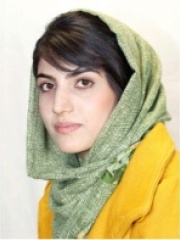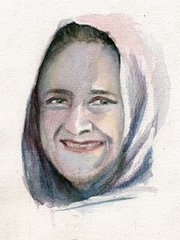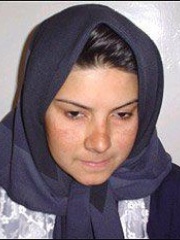


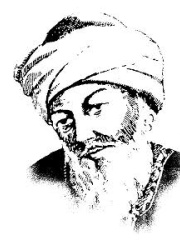


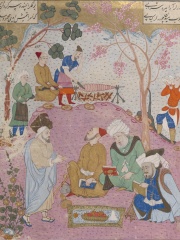

The Most Famous
WRITERS from Afghanistan
This page contains a list of the greatest Afghan Writers. The pantheon dataset contains 7,302 Writers, 16 of which were born in Afghanistan. This makes Afghanistan the birth place of the 60th most number of Writers behind South Korea, and Chile.
Top 10
The following people are considered by Pantheon to be the top 10 most legendary Afghan Writers of all time. This list of famous Afghan Writers is sorted by HPI (Historical Popularity Index), a metric that aggregates information on a biography's online popularity. Visit the rankings page to view the entire list of Afghan Writers.

1. Rumi (1207 - 1273)
With an HPI of 86.64, Rumi is the most famous Afghan Writer. His biography has been translated into 109 different languages on wikipedia.
Jalāl al-Dīn Muḥammad Rūmī, commonly known as Rumi (30 September 1207 – 17 December 1273), was a Sufi mystic, poet, and founder of the Islamic brotherhood known as the Mevlevi Order. Rumi is an influential figure in Sufism, and his thought and works loom large both in Persian literature and mystic poetry in general. Today, his translated works are enjoyed all over the world. The rapidly advancing Mongol hordes forced his family to flee west early on in his life. After spending time in various cities across Iran, Baghdad, and Damascus, he settled in Konya with his family at age 19. Until recently, Konya had been a province of the Eastern Roman Empire, hence his name, Rumi, i.e. "the Roman". Although he was exposed to Sufi thought from his early childhood, he was expected to follow his fathers footsteps as an Islamic scholar. However, the arrival to Konya of the mysterious wandering dervish, Shams Tabrīzī, would alter the course of his life permanently. Rumi and Shams became infatuated with each other, causing Rumi to neglect his duties. When Shams mysteriously disappeared, Rumi experienced an intense period of grief reflected in his Divan of Shams Tabrīzī. This was the defining moment in the evolution of Rumi's spiritual worldview, and marked the beginning of his poetic output. His Masnavi, often called a "Qur'an in Persian", is considered one of the greatest poems of the Persian language. Many Muslims, particularly in the Turko-Persian cultural sphere, regard the Masnavi as one of the most important works of Islamic literature, falling behind only the Quran. Rumi's works are widely read today across his native Greater Iran as well as in Turkey, where the Sufi brotherhood he founded is based. His poems have been translated into many of the world's languages, and Rumi has been described as the "world's most popular poet." In the United States, he has become the best selling poet in recent years.

2. Ali-Shir Nava'i (1441 - 1501)
With an HPI of 74.31, Ali-Shir Nava'i is the 2nd most famous Afghan Writer. His biography has been translated into 60 different languages.
'Ali-Shir Nava'i (9 February 1441 – 3 January 1501), also known as Nizām-al-Din ʿAli-Shir Herawī (Chagatai: نظام الدین علی شیر نوایی) was a Timurid poet, writer, statesman, linguist, Hanafi Maturidi mystic and painter who was the greatest representative of Chagatai literature. Nava'i believed that his native Chagatai Turkic language was superior to Persian for literary purposes, an uncommon view at the time and defended this belief in his work titled Muhakamat al-Lughatayn (The Comparison of the Two Languages). He emphasized his belief in the richness, precision and malleability of Turkic vocabulary as opposed to Persian. Due to his distinguished Chagatai language poetry, Nava'i is considered by many throughout the Turkic-speaking world to be the founder of early Turkic literature. Many places and institutions in Central Asia are named after him, including the province and city of Navoiy in Uzbekistan. Many monuments and busts in honour of Alisher Navoi's memory have been erected in different countries and cities such as Tashkent, Samarkand, Navoiy of Uzbekistan, Ashgabat of Turkmenistan, Ankara of Turkey, Seoul of South Korea, Tokyo of Japan, Shanghai of China, Osh of Kyrgyzstan, Astana of Kazakhstan, Dushanbe of Tajikistan, Herat of Afghanistan, Baku of Azerbaijan, Moscow of Russia, Minsk of Belarus, Lakitelek of Hungary and Washington, D.C. of the United States.

3. Khaled Hosseini (b. 1965)
With an HPI of 67.06, Khaled Hosseini is the 3rd most famous Afghan Writer. His biography has been translated into 69 different languages.
Khaled Hosseini or Khalid Husseini (; Pashto/Persian: خالد حسینی, Dari: [ˈxɑːlɪd hʊˈsæjniː]; born March 4, 1965) is an Afghan-American novelist, UNHCR goodwill ambassador, and former physician. His debut novel The Kite Runner (2003) was a critical and commercial success; the book and his subsequent novels have all been at least partially set in Afghanistan and have featured an Afghan as the protagonist. Hosseini's novels have spread awareness about Afghanistan's people and culture. Hosseini was briefly a resident of Iran and France after being born in Kabul, Afghanistan, to a diplomat father. When Hosseini was 15, his family applied for asylum in the United States, where he later became a naturalized citizen. Hosseini did not return to Afghanistan until 2003 when he was 38, an experience similar to that of the protagonist in The Kite Runner. In later interviews, Hosseini acknowledged that he suffered from survivor's guilt for having been able to leave the country prior to the Soviet invasion and subsequent wars. After graduating from college, Hosseini worked as a physician in California, a situation he likened to "an arranged marriage". The success of The Kite Runner meant he was able to retire from medicine in order to write full-time. His three novels have all reached various levels of critical and commercial success. The Kite Runner spent 101 weeks on The New York Times Best Seller list, including three weeks at number one. His second novel, A Thousand Splendid Suns (2007), spent 103 weeks on the chart, including 15 at number one while his third novel, And the Mountains Echoed (2013), remained on the chart for 33 weeks. In addition to writing, Hosseini has advocated for the support of refugees, including establishing with the UNHCR the Khaled Hosseini Foundation to support Afghan refugees returning to Afghanistan.

4. Sanai (1080 - 1131)
With an HPI of 63.41, Sanai is the 4th most famous Afghan Writer. His biography has been translated into 25 different languages.
Hakim Abul-Majd Majdūd ibn Ādam Sanā'ī Ghaznavi (Persian: حکیم ابوالمجد مجدود بن آدم سنایی غزنوی), more commonly known as Sanai, was a poet in the Ghaznavid Empire, who wrote in Persian. He was born in 1080 and died in 1150.
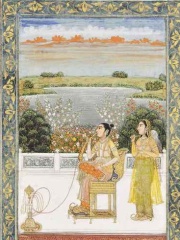
5. Gulbadan Begum (1523 - 1603)
With an HPI of 62.07, Gulbadan Begum is the 5th most famous Afghan Writer. Her biography has been translated into 27 different languages.
Gulbadan Begum (20 November 1522 – 7 February 1603) was a Mughal princess and the daughter of Emperor Babur, the founder of the Mughal Empire. She is best known as the author of Humayun-Nama, the account of the life of her half-brother and Babar's successor, Emperor Humayun, which she wrote on the request of her nephew and Humayun's son, Emperor Akbar. Gulbadan's recollection of Babur is brief, but she gives a refreshing account of Humayun's household and provides rare material regarding his confrontation with her half-brother, Kamran Mirza. She records the fratricidal conflict among her brothers with a sense of grief. Gulbadan Begum was about eight years old at the time of her father's death in 1530 and was brought up by her older half-brother, Humayun. She was married to a Chagatai noble, her cousin, Khizr Khwaja Khan, the son of Aiman Khwajah Sultan, son of Khan Ahmad Alaq of the Turpan Khanate in Moghulistan at the age of seventeen. She spent most of her life in Kabul. In 1557, she was invited by her nephew, Akbar, to join the imperial household at Agra. She wielded great influence and respect in the imperial household and was much loved both by Akbar and his mother, Hamida Banu Begum. Gulbadan Begum is mentioned throughout the Akbarnama (lit. 'Book of Akbar') of Abu'l Fazl and much of her biographical details are accessible through the work. Along with several other royal women, Gulbadan Begum undertook a pilgrimage to Mecca and returned home seven years later in 1582. She died in 1603.

6. Unsuri (980 - 1039)
With an HPI of 60.72, Unsuri is the 6th most famous Afghan Writer. His biography has been translated into 23 different languages.
Abu'l-Qasim Hasan Unsuri Balkhi (Persian: ابوالقاسم حسن عنصری بلخی; died 1039/1040) was a 10th–11th-century Persian poet. Unsuri is said to have been born in Balkh, today located in Afghanistan, and he eventually became a poet of the royal court of Mahmud of Ghazni, and was given the title Malik us-Shu'ara (King of Poets) under Mahmud. His Divan is said to have contained 30,000 distichs, of which only 2500 remain today. It includes the romance epic Vamiq u 'Adhra, which ultimately derives from the Ancient Greek novel Metiochus and Parthenope.

7. Rabia Balkhi (b. 1000)
With an HPI of 59.32, Rabia Balkhi is the 7th most famous Afghan Writer. Her biography has been translated into 21 different languages.
Rabia Balkhi (Arabic: رابعة بنت كعب, Persian: رابعه بلخی) also known as Rabia al-Quzdari (or Khuzdari), was a 10th-century writer who composed poetry in Persian and Arabic. She is the first known female poet to write in Persian. A non-mystic poet, her imagery was later transformed into that of a mystic poet by authors such as Attar of Nishapur (died 1221) and Jami (died 1492). She became a semi-legendary figure, famous for her love story with the slave Bektash. Her shrine is located in the mausoleum of the 15th-century Naqshbandi Sufi Khwaja Abu Nasr Parsa (died 1460) in the city of Balkh, now present-day Afghanistan. She is celebrated in the Balochistan province of Pakistan, Afghanistan and Iran through various schools, hospitals, and roads being named after her.

8. Farrukhi Sistani (980 - 1037)
With an HPI of 58.50, Farrukhi Sistani is the 8th most famous Afghan Writer. His biography has been translated into 18 different languages.
Abu'l-Hasan Ali ibn Julugh Farrukhi Sistani (Persian: ابوالحسن علی بن جولوغ فرخی سیستانی), better known as Farrukhi Sistani (فرخی سیستانی; c. 1000 – 1040) was one of the most prominent Persian court poets in the history of Persian literature. Initially serving a dehqan in Sistan and the Muhtajids in Chaghaniyan, Farrukhi entered the service of the Ghaznavids in 1017, where he became the panegyrist of its rulers, Mahmud (r. 999–1030) and Mas'ud I (r. 1030–1040), as well as numerous viziers and princes.

9. Atiq Rahimi (b. 1962)
With an HPI of 55.59, Atiq Rahimi is the 9th most famous Afghan Writer. His biography has been translated into 26 different languages.
Atiq Rahimi (Persian: عتیق رحیمی) (born 26 February 1962 in Kabul) is a French-Afghan writer and filmmaker.
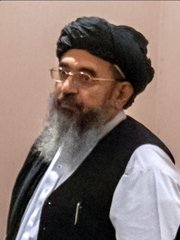
10. Abdul Hakim Haqqani (b. 1967)
With an HPI of 48.00, Abdul Hakim Haqqani is the 10th most famous Afghan Writer. His biography has been translated into 25 different languages.
Abdulhakim Haqqani (born 1967), also known as Abdulhakim Ishaqzai, is an Afghan Islamic scholar and writer who has been the chief justice of Afghanistan in the Islamic Emirate of Afghanistan since 2021. He has also served as chief justice of the Supreme Court in the 1996–2001 Islamic Emirate of Afghanistan. He was the chairman of the Taliban negotiation team in the Qatar office. He is one of the founding members of the Taliban and was a close associate of the late leader Mullah Mohammed Omar. In July 2025, the International Criminal Court issued arrest warrants for Haqqani over charges claiming the mistreatment of women by the Taliban in Afghanistan.
People
Pantheon has 16 people classified as Afghan writers born between 980 and 1992. Of these 16, 8 (50.00%) of them are still alive today. The most famous living Afghan writers include Khaled Hosseini, Atiq Rahimi, and Abdul Hakim Haqqani. The most famous deceased Afghan writers include Rumi, Ali-Shir Nava'i, and Sanai. As of April 2024, 3 new Afghan writers have been added to Pantheon including Abdul Hakim Haqqani, Chékéba Hachemi, and Rangina Hamidi.
Living Afghan Writers
Go to all RankingsKhaled Hosseini
1965 - Present
HPI: 67.06
Atiq Rahimi
1962 - Present
HPI: 55.59
Abdul Hakim Haqqani
1967 - Present
HPI: 48.00
Niloofar Rahmani
1992 - Present
HPI: 42.90
Nadia Ghulam
1985 - Present
HPI: 41.31
Chékéba Hachemi
1974 - Present
HPI: 38.10
Fatima Bhutto
1982 - Present
HPI: 36.44
Rangina Hamidi
HPI: 33.86
Deceased Afghan Writers
Go to all RankingsRumi
1207 - 1273
HPI: 86.64
Ali-Shir Nava'i
1441 - 1501
HPI: 74.31
Sanai
1080 - 1131
HPI: 63.41
Gulbadan Begum
1523 - 1603
HPI: 62.07
Unsuri
980 - 1039
HPI: 60.72
Rabia Balkhi
1000 - Present
HPI: 59.32
Farrukhi Sistani
980 - 1037
HPI: 58.50
Nadia Anjuman
1981 - 2005
HPI: 47.54
Newly Added Afghan Writers (2025)
Go to all RankingsAbdul Hakim Haqqani
1967 - Present
HPI: 48.00
Chékéba Hachemi
1974 - Present
HPI: 38.10
Rangina Hamidi
HPI: 33.86

